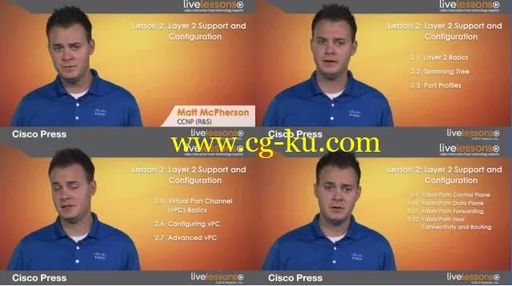Duration: 11 hours | Video: h264, 1280x720 | Audio: AAC, 44 KHz, 2 Ch | 4.4 GBGenre: eLearning | Language: English | Skill Level: IntermediateMore than 11 hours of video instruction on NX-OS technologies and configuration, including Layer 2 and Layer 3, Multicast, Security, LISP, MPLS, United Fabric and more.
DescriptionNX-OS Configuration Fundamentals LiveLessons is a unique video product that provides a solid understanding of NX-OS technologies across five product families.
The video lessons guide the viewer from an introduction to the product families and operating system, through Layer 2 and 3 capabilities, before delving into multicast and security.
Next, the lessons examine high availability, unique embedded serviceability features, Unified Fabric, and the Nexus 1000v.
The final lessons cover QoS, Overlay Transport Virtualization (OTV), Multiprotocol Label Switching (MPLS), and Locator ID Separator Protocol (LISP).
NX-OS Configuration Fundamentals LiveLessons contains 13 individual video lessons, divided into 94 sub-lessons, for a total of nearly 12 hours of instruction.
The videos consist of audio instruction, animations, and video screencasts.
Each video lab presents detailed objectives, lab diagrams, and video captures.
Audio instruction throughout offers detailed explanations, tips, and configuration verifications.
The 13 video lessons cover the following topics:--Lesson 1: Introduction to NX-OS--Lesson 2: Layer 2 Support and Configuration--Lesson 3: Layer 3 Support and Configuration--Lesson 4: NX-OS Multicast--Lesson 5: NX-OS Security--Lesson 6: High Availability--Lesson 7: Embedded Services--Lesson 8: Unified Fabric--Lesson 9: Nexus 1000v--Lesson 10: Quality of Service (QoS)--Lesson 11: Overlay Transport Virtualization (OTV)--Lesson 12: Layer 3 Virtualization and MPLS--Lesson 13: Locator ID Separator Protocol (LISP)Skill Level* IntermediateWhat You Will Learn--Layer 2 and Layer 3 Support and Configuration--NX-OS Multicase--NX-OS Security--High Availability--Embedded Services--United Fabric--Nexus 1000v--Quality of Service--Overlay Transport Virtualization (OTV)--Layer 3 Virtualization and MPLS--Locator ID Separator Protocol (LISP)Who Should Take This CoursePrimary audience: The target audience for this book is the network engineer or operator.
Secondary audience: Help desk analysts or network administrators as well as data center certification candidates.
The students should be intermediate to expert level.
Course RequirementsThese LiveLessons assume common knowledge of Cisco IOS and network switching and routing theory.
The typical student should have at least a CCNP certification and should be responsible for configuration and day-to-day operations of enterprise-level data center switches.
The student could also be responsible for planning the interconnect strategy for data center devices.
Table of ContentsLesson 1: Introduction to NX-OSLesson 1.1: NX-OS OverviewLesson 1.2: NX-OS Command Line and ManagementLesson 1.3: NX-OS File SystemsLesson 1.4: Nexus Product UpdatesLesson 1.5: Virtual Device Context (VDC) FundamentalsLesson 1.6: VDC Advanced TopicsLesson 1.7: Troubleshooting CommandsLesson 2: Layer 2 Support and ConfigurationLesson 2.1: Layer 2 BasicsLesson 2.2: Spanning TreeLesson 2.3: Port ProfilesLesson 2.4: Port ChannelsLesson 2.5: Virtual Port Channel (vPC) BasicsLesson 2.6: Configuring vPCLesson 2.7: Advanced vPCLesson 2.8: vPC Failure ScenariosLesson 2.9: FabricPath Control PlaneLesson 2.10: FabricPath Data PlaneLesson 2.11: FabricPath ForwardingLesson 2.12: FabricPath Host Connectivity and RoutingLesson 2.13: FabricPath Configuration and TroubleshootingLesson 2.14: Dynamic Fabric Automation (DFA) IntroductionLesson 3: Layer 3 Support and ConfigurationLesson 3.1: EIGRP ConfigurationLesson 3.2: EIGRP Verification and TroubleshootingLesson 3.3: OSPF ConfigurationLesson 3.4: OSPF Verification and TroubleshootingLesson 3.5: IS-IS ConfigurationLesson 3.6: IS-IS Verification and TroubleshootingLesson 3.7: Basic BGP ConfigurationLesson 3.8: BGP VerificationLesson 3.9: First Hop Redundancy Protocols (FHRPs)Lesson 3.10: Redistribution and Policy-Based RoutingLesson 4: NX-OS MulticastLesson 4.1: Multicast BasicsLesson 4.2: Internet Group Management Protocol (IGMP) and Protocol Independent Multicast (PIM)Lesson 4.3: Basic Multicast ConfigurationLesson 4.4: Rendezvous Point (RP) RedundancyLesson 4.5: Advanced Multicast ConfigurationLesson 4.6: Control Plane Policing (CoPP) and MulticastLesson 5: NX-OS SecurityLesson 5.1: NX-OS Security BasicsLesson 5.2: Access Control List (ACL) BasicsLesson 5.3: Advanced ACLsLesson 5.4: NX-OS Data Center Encryption 802.1ae MacSecLesson 5.5: Storm ControlLesson 5.6: Control Plane Policing (CoPP)Lesson 6: High AvailabilityLesson 6.1: Nexus Hardware BasicsLesson 6.2: Generic Online Diagnostics (GOLD)Lesson 6.3: NX-OS High Availability Architecture and FeaturesLesson 6.4: NX-OS Software Upgrades — Cold UpgradeLesson 6.5: NX-OS Software Upgrades — ISSULesson 7: Embedded ServicesLesson 7.1: SPAN in NX-OSLesson 7.2: ERSPAN in NX-OSLesson 7.3: Embedded AnalyzerLesson 7.4: Smart Call HomeLesson 7.5: Checkpoint Configuration and RollbackLesson 7.6: NetFlowLesson 7.7: Network Time ProtocolLesson 8: Unified FabricLesson 8.1: Unified Fabric BasicsLesson 8.2: FCoE BasicsLesson 8.3: N Port VirtualizationLesson 8.4: Unified Fabric Configuration - Single HopLesson 8.5: Unified Fabric Configuration - MultihopLesson 9: Nexus 1000vLesson 9.1: Nexus 1000v BasicsLesson 9.2: Nexus 1000v Multi-Hypervisor IntegrationLesson 9.3: Nexus 1000v Stretched Deployment GuidelinesLesson 9.4: Nexus 1000v and VXLANLesson 9.5: Nexus 1000v and CTSLesson 9.6: Nexus 1000v VSM and VEM SecurityLesson 9.7: Nexus 1000v Storm ControlLesson 10: Quality of Service (QoS)Lesson 10.1: Quality of Service FundamentalsLesson 10.2: QoS in NX-OSLesson 10.3: QoS on Nexus 7000Lesson 10.4: QoS on Nexus 5000Lesson 10.5: QoS on Nexus 1000vLesson 11: Overlay Transport Virtualization (OTV)Lesson 11.1: OTV BasicsLesson 11.2: OTV Network Requirements and OptionsLesson 11.3: OTV Multi-homing and Failure IsolationLesson 11.4: First Hop Redundancy Protocol (FHRP) Localization and OTVLesson 11.5: OTV Traffic DepolarizationLesson 11.6: OTV VLAN TranslationLesson 11.7: OTV Broadcast ControlLesson 11.8: OTV Integration with FabricsLesson 11.9: OTV and LISP Integration Whiteboard SessionLesson 12: Layer 3 Virtualization and MPLSLesson 12.1: Virtual Routing and ForwardingLesson 12.2: Route Import/ExportLesson 12.3: MPLS BasicsLesson 12.4: Detailed MPLS TopicsLesson 12.5: MPLS Layer 2 VPNsLesson 12.6: MPLS Layer 2 VPN ConfigurationLesson 13: Locator ID Separator Protocol (LISP)Lesson 13.1: LISP BasicsLesson 13.2: LISP Roles and OperationsLesson 13.3: IP Mobility/Host Mobility with Extended SubnetsLesson 13.4: IP Mobility Without Extended SubnetsLesson 13.5: LISP Multihop and Host MobilityLesson 13.6: LISP Multihop MobilityLesson 13.7: LISP Best Practices




发布日期: 2018-12-07